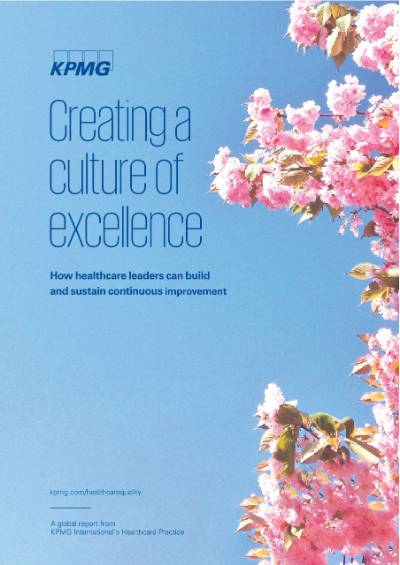Globally, healthcare leaders are increasingly looking to embed the principles of continuous improvement in their organizations. Empowering staff to deliver safe, high-quality, reliable care can provide a step-change in results. In this article, we summarize the twelve key findings from our new global report examining how healthcare leaders can build and sustain a culture of continuous improvement in healthcare.
Continuous improvement is a systematic, sustainable approach to enhancing the quality of care and outcomes for patients. Building a continuous improvement culture is not a turnaround project or a quick fix but a journey which never really ends, requiring commitment, investment and persistence. To understand this journey, we interviewed 20 senior health system leaders from organisations across North America, Europe, Middle East, Asia and Australia on their experiences of trying to bring about an improvement culture.
The goal of continuous improvement is 'operational excellence' - establishing a way of working which delivers improvements in care quality and safety by the everyday use of continuous improvement techniques. Continuous improvement is driven and owned by frontline staff, reinforced by specialised, ongoing training and supported by the entire organisation - starting with the board and the chief executive and permeating everywhere from the finance and HR departments to the IT team.
It has to be underpinned by the right leadership behaviours. Autocratic management is toxic to improvement, while those who constantly seek ways to unleash the creativity and skill of their colleagues have a chance to succeed. Leaders who include, support, mentor and ask questions of their team rather than issue instructions are the people who can make this happen. Everyone needs to understand how they are expected to behave.
This is a culture shift towards a new philosophy of being a self-analytical, self-critical, learning organisation which empowers frontline staff to identify the root causes of problems in systems and processes and to develop the solutions.
This article distils the key points from the interviews with our healthcare leaders, looking first at implementing, and then at sustaining, a culture of continuous improvement.
Implementing a culture of continuous improvement
- Creating a new end-to-end management system
Continuous improvement requires a new management system, replacing the traditional project-based mentality with behaviours, tools and techniques which help managers support frontline workers in identifying and solving problems themselves. This system is the engine room for sustainable improvement, aligning improvement efforts with the organisation's goals - it's 'True North'.
The changes required in culture and actions don't always come naturally. Skills such as using and spreading problem-solving techniques need to be taught, and supported through mentoring and coaching. Managers need to develop the discipline to sustain this work over months and years, and understand that this new way of working is now the day job. - Get senior leaders' commitment to change themselves, not just changing others
This approach needs the senior leadership and board to understand it, support it and be seen to be committed to it. Ways that leaders demonstrated their commitment included role modelling the behaviours they expected - asking questions rather than handing down solutions, embracing problems as opportunities for improvement and constantly trying to remove obstacles - and being seen more on the wards. Getting involved helps executives appreciate what resources and support are needed to build a problem-solving culture.
Shifting leadership behaviours from a traditional command-and-control, results-driven mentality isn't easy and takes time. Many organisations highlighted the value of their board and senior staff visiting high-performing organisations that had adopted continuous improvement to see what 'good' looks like.
Leadership needs to be stable and committed over several years. Many organisations highlighted the importance of succession planning and recruiting staff with experience of continuous improvement. - Go slower to go fast
Implementation must not be rushed. Changing culture takes time and persistence to get it right, particularly in organisations that have seen many improvement initiatives come and go. Change fatigue, misunderstandings about what continuous improvement really is and inadequate capacity and resources are just some of the barriers to overcome.
Take the time to plan and deliver training at an appropriate pace. Working steadily to embed change, review progress and adapt as required can mean a multi-year journey before staff and departments are fully trained. Nearly all the organisations we interviewed had initially brought in external expert support to advise on and help deliver initial implementation, with a gradual transition to self-sufficiency. - Create a common language staff understand
Introducing new ways of working can feel difficult, unsettling, even threatening, so organisations make substantial efforts to communicate with staff before implementing changes. Done well, the most enthusiastic staff can quickly become champions and ambassadors for change among their colleagues; done badly, poor staff engagement will cause the programme to falter or fail.
Management-speak terms such as 'Lean' alienate staff and create misconceptions about cost-cutting and loss of autonomy, leading to resistance. Most organisations had developed their own plain language around continuous improvement, motivating staff with terms which highlighted the benefits for patients. This language then becomes the 'brand' for the organisation which encourages a sense of pride and collective goals.
This patient focused, straightforward approach should be at the heart of a wider communication strategy to build and sustain momentum. Some organisations run staff and patient communications campaigns for up to six months before implementation.
Staff should come together regularly to discuss solutions to common problems so that learning can be shared. Success stories and early wins should be used to create a sense that frontline staff are making it all happen and to drive home the message that this is a new way of working, not just a passing fad. Staff talking to each other formally and informally about their work is a powerful way to spread news, while senior leaders should be seen championing the change. - Tailor the training
Continuous improvement ultimately rests on staff understanding and applying the new behaviours. While simple in theory, the challenge is often underestimated.
Supportive coaching, responsive to staff needs, can make all the difference. It should mirror their pace and continue long enough to embed change. A few training sessions alone will not deliver the transformation required.
Staff will engage differently. Many organisations found nurses were quick to understand and engage with continuous improvement methods. Their frontline roles allow them to identify many improvement opportunities, while coaching helps empower them to make changes. Doctors were often more challenging to engage, with conflicting priorities, heavy workloads, change fatigue and scepticism all contributing. Managers benefit from coaching to help them role-model the new behaviours and create an environment where problems are seen as improvement opportunities rather than a cause for criticism.
Training should be tailored to anticipate these differences, such as winning over doctors by emphasising the scientific approach to problem-solving and the data demonstrating progress. - Demonstrate early impact
Publicising and celebrating early successes engages staff and patients and builds momentum by enabling staff to say to colleagues 'this works'. Making results visible is important to help demonstrate a positive impact, and harnessing 'quick wins' can be a powerful tool to accelerate implementation.
In the early stages, process measures such as the number of staff trained and the number of improvement suggestions submitted can help show uptake and engagement. As implementation matures and improvements begin to feed through, defining successes can shift to more outcome-focused measures such as the reduction in falls.
Sustaining a culture of continuous improvement - Pick fewer priorities and stick to them
Many organisations are overwhelmed by targets and outcomes. Without prioritisation, staff bravely attempt to meet all of them, firefighting becomes the norm and frustration and demoralisation set in.
Achieving sustainable improvement takes focus. Organisations highlighted the importance of culling vast numbers of targets and moving towards a smaller set of priorities they can stick with to deliver 'breakthrough' change.
While the ideal number varies depending on an organisation's position and resources, leaders typically recommended focussing on three to four priorities, and certainly no more than 10. They should be aligned with strategic goals such as patient satisfaction, quality of care, staff satisfaction and financial efficiency, and communicated to staff to ensure clarity and shared direction.
Seeing these priorities through, often in the face of more pressing day-to-day challenges, requires resolute leadership. This involves being realistic about the time required to tackle difficult challenges. Understanding root causes and designing and deploying solutions takes time to get right.
Interviewees recommended focusing on the selected priorities for one to two years until goals are reached, then replacing them with new priorities while continuing to monitor performance to ensure progress does not slip. - Imbed change at all levels
In moving to a continuous improvement culture, organisations typically invest heavily in coaching executive leaders and frontline teams. Frontline managers are responsible for the majority of financial, quality, safety and service decisions and should be the main recipients of coaching. But too often middle managers get left behind and end up blocking progress.
Managers typically manage in their own way, with no consistent approach to problems and no clear system for them to understand their performance. Managing continuous improvement requires systematically applying a new set of behaviours and tools, and standardising management styles.
This transforms managers from firefighters to enablers - leading daily improvement huddles, talking about progress and successes and guiding staff to develop new ideas themselves rather than imposing solutions on them.
Many organisations realised the dangers of neglecting middle managers late, when progress plateaued or they found themselves losing frustrated middle management staff. Middle management's role needs to be recognised and appreciated. - Align your organisation to deliver your 'True North'
An organisation need clarity around what matters most. The handful of metrics which represent the organisation's goals is often referred to as the 'True North'. Prioritising and articulating them allows staff from the board to the frontline to rally around a common purpose, focus efforts, make best use of time and resources and secure the biggest impact.
Typically, executive leaders will consult and review the evidence and data to determine the key goals, the associated performance indicators and the improvement targets, but the leadership do not dictate how those targets will be reached. Instead they empower staff to determine the incremental improvements that will help achieve them. - Engage and empower patients
Continuous improvement should always focus on what matters to the patient. At a minimum, patients can help determine the areas for quality improvement work, test the potential ideas for delivery and evaluate the results.
Some organisations encourage patients and carers to suggest improvements and even participate in daily ward huddles to review progress and performance. The feasibility of this can depend on the healthcare setting and the ability of patients or carers to participate. We heard examples from paediatric hospitals, where parents are keen to engage, and mental healthcare providers, where patients are more likely to be up and about on the ward.
Initially staff have found direct patient participation awkward, and expressed concerns that discussions around performance, problems and improvement should be private. This reflects worries that patients or carers will misunderstand discussions, or a feeling that they should be shielded from problems. But none of the organisations we talked to had experienced difficulties. On the contrary, patients were pleased to see measurement and discussion of improvements.
The biggest win from promoting patient engagement may come from keeping staff focussed on the ultimate reason for continuous improvement. - Technology can support, but get your management systems and culture in order first
Technology can play a key role in supporting continuous improvement, but organisations stressed the need to improve culture and management systems first. Technology should never be a sticking plaster for underlying issues; if you start with tech as the solution you are likely to be missing the problem.
The starting point for improvement is understanding the current state, which means making better use of data. Analytics and real-time monitoring can speed up identification of the biggest problems and help identify root causes.
Getting this data into the hands of staff so that they can use it to improve care can be game-changing. Several organisations have brought their 'True North' metrics together into digital dashboards to improve visibility and reporting. - Remember there are no quick fixes
Continuous improvement is a philosophy, not a quick fix. It typically takes two to five years to embed the new ways of working across an organization as it understands, adapts, and reflects this through a change in behaviours.
This long-term approach can be a challenge, particularly for organisations struggling with severe performance or financial issues. Continuous improvement has to be seen as a long-term investment in the organisation's health, driven by committed and stable leadership.
Continuous improvement benefits from the time and space to grow, such as by starting with low-risk projects as vehicles to engage and train staff.
Conclusion
This sort of deep culture change can be challenging, but the ultimate return is far greater than any isolated improvement project. The success of the organisations we interviewed demonstrates the huge global potential for continuous improvement in pursuit of operational excellence in healthcare.
What distinguishes these institutions is long-term commitment and a desire to end the vicious cycle of short-term gains followed by a relapse into old ways. They have made improvement part of daily work, and supported staff with on-the-job coaching to develop the skills and confidence to challenge the status quo.
The rigor and discipline required should be seen as an enabler, not a straitjacket, helping to channel the passion of healthcare professionals into practical solutions that meet the challenge of 21st-century healthcare to irrevocably raise quality and reduce costs over the decades to come.
Authors & Contributors
For further information on this report, or to discuss our global experience in building a sustainable culture of continuous improvement, please contact:
Gordon Burrill, Partner and Global Operational Excellence co-lead, KPMG Canada (gburrill@kpmg.ca)
Jason Parker, Partner and Global Operational Excellence co-lead, KPMG in the UK (jason.parker@kpmg.co.uk)
Dr. Ed Fitzgerald, Global Healthcare Executive, KPMG International (edward.fitzgerald@kpmg.co.uk)
Connect with us
- Find office locations kpmg.findOfficeLocations
- kpmg.emailUs
- Social media @ KPMG kpmg.socialMedia



